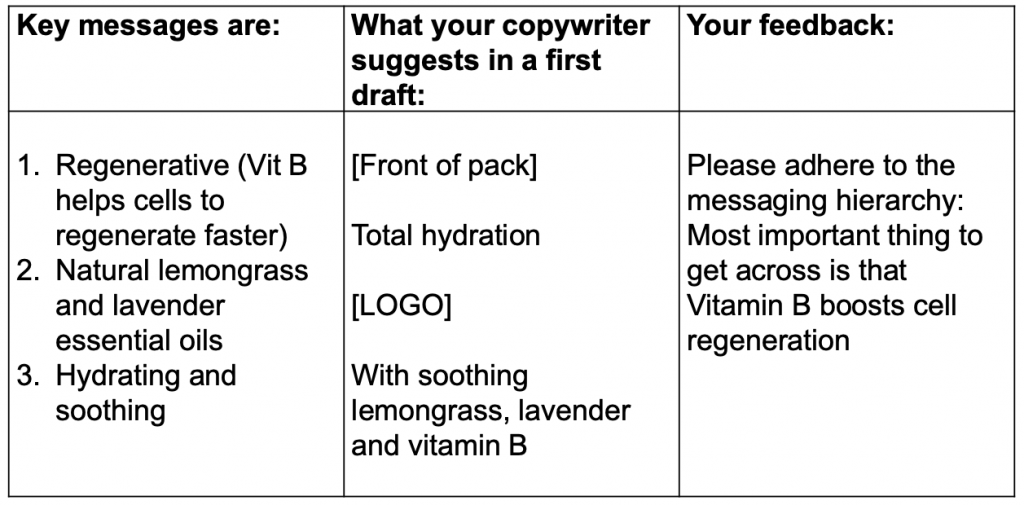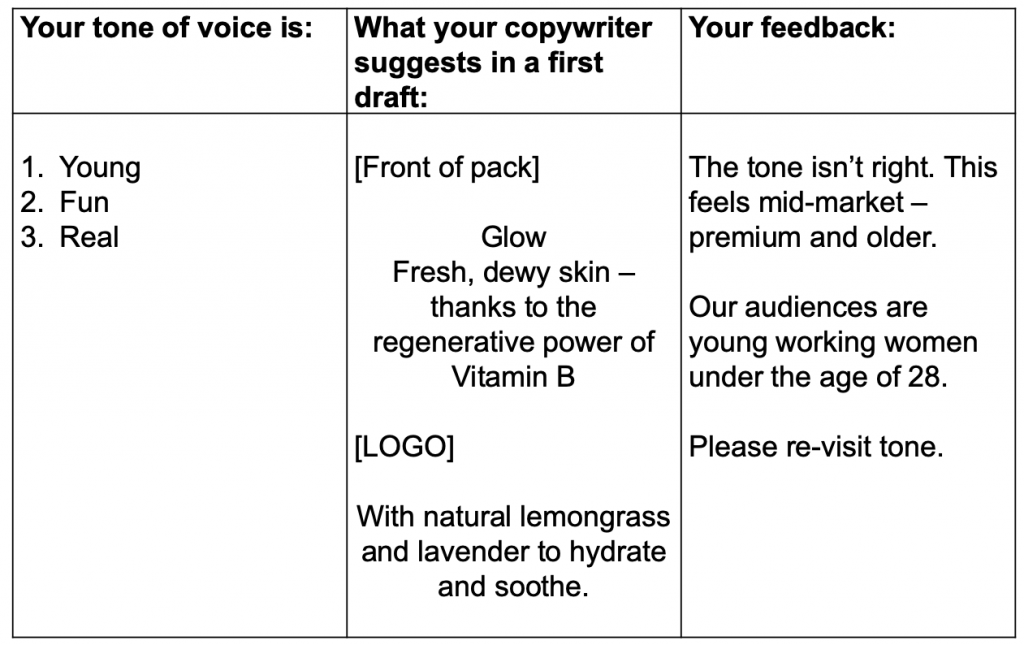
So you briefed your copywriter. And they’re busy creating your new way of explaining your product or service. You (quite rightly) have sky-high expectations. Then the first drafts arrive. You open them and… hmm, well, nothing is setting your world on fire.
Your next step is feeding back. So you go back to your copywriter – either in tracked changes or better, in a conversation – and you say: “I don’t like it.”
A decent copywriter will ask you to explain why. But the thing is, you don’t know why. You just don’t like it. It’s not giving you happy feelings. It’s not something you’re eager to get out there to your customers.
So stalemate. Your copywriter thinks they’ve delivered on your brief. You don’t like it. You may already be ringing around to get recommendations for another copywriter. Or you may be looking at the old version and thinking: “Well maybe it wasn’t that bad after all…”
When you’re feeding back on copy, these are useful things to bear in mind if you want to build a relationship, get work turned around quickly – and critically, end up with the text you want and need:
Your brief
How precise was your brief? Did you set out exactly:
- The position you want to occupy in your marketplace – and the key messages that must be used to achieve this?
- Your audiences – who they are, why this is interesting to them?
- Key terms (if SEO is an issue)?
- Your preference for word counts?
- Your tone of voice?
Depending on the type of project, your copywriter may need even more information. Things like user pathways through websites, information about devices the content is most likely to be accessed through – or limitations imposed by regulation or preference.
If you didn’t set these things out, now might be a good time to sharpen your brief. Because without a precise brief, it’s a bit like telling a builder you’d like a new porch of about six square metres. You come home thinking you’ll be able to hang up your coat and take off your shoes in your new porch – but then you can’t see anywhere for hooks to go. And the builder has used red bricks instead of stone. The builder has given you a six-metre-square porch. They might think they’ve given you a very good porch. It’s just that in the briefing process, the specifics got lost.
The good news is that copy is much easier to fix than a brick building. So here’s what else to consider when evaluating and feeding back…
The elements of copy
Commercial writing is made up of two elements:
Messaging
This is the “what”. Your messages are what you want to say, and the order you want to say them in. So if you’re looking at a piece of copy that isn’t working for you – is it because it’s fundamentally saying the wrong thing? Or is it saying the right things – kind of – but with the emphasis in the wrong place?
If this is the case, then you can feed back to your copywriter that the messaging is wrong or the order of the messages is wrong.
Here’s a (very simple) example:

So in draft two, you should get:
[Front of pack]
Glow
Fresh, dewy skin – thanks to the regenerative power of Vitamin B
[LOGO]
With natural lemongrass and lavender to hydrate and soothe.
If you don’t know what your key messages are – or the order they should be in – it may be that you’re missing a crucial piece of brand thinking that would allow you to brief precisely. Your copywriter may be able to help you with this. A hybrid brand consultant copywriter like the people you’ll find at Wordtree would certainly be able to help you with this.
But you can’t expect it to happen magically simply by “wordsmithing”. Only you know what you want to say about your product. Your copywriter can help you to articulate this, but without dedicated research and questioning – and possibly doing some more in-depth brand work with you – they can’t be expected to know what the most important messages you need to say are. If this situation develops, you end up in a best guessing game. Your copywriter may be trying to infer from your conversations what you’d like to say. And you only know that you’ll know it when you see it. This way of tackling messaging can be frustrating for both parties.
Your copywriter will say: “OK, just let me know what to say and I’ll write it.” Meantime, you may be thinking: “But surely that’s your job – you tell me what I want to say.”
However, being a client means being involved – in exactly the same way as a householder asking a builder to create a new porch for them.
We find it works best when an approach is co-created. Of course, you can expect your copywriter to suggest ideas, to highlight approaches used by competitors – and to offer an opinion. But you need to do the same thing too. You need to tell the builder that you want somewhere to hang your coat, that the floor has to be polished concrete and the door needs to be solid wood, not glass.
It’s similar when you brief a copywriter. You need to explain what the copy is supposed to do, who is going to read it and what it’s supposed to make them feel and do.
Tone of voice
The other core element of commercial writing is tone. A brand’s tone of voice is its personality expressed in words. If you have an established tone of voice, you need to share this with your copywriter. If you don’t, you at least need to explain what your brand’s personality is… or which brands you’d like to sound like.
Tone is the way something is expressed, rather than what it expresses.
Let’s imagine the skin cream copy gets the messaging right, but the tone is wrong:

With feedback like this, you should very quickly get to a V2 which reads more like:
[Front of pack]
Wide-awake skin
With Vitamin B superpower
[LOGO]
With natural essential oils to keep your skin amazing all day.
Tonally, these two versions are very different – but they’re saying exactly the same things. The messaging is right, the tone is different.
If you ever reach the “I don’t like it” stage, try to deconstruct what exactly isn’t working for you. Is it the message? Is it the tone? Is the copy missing key words and phrases? Is it too long? Too short? Is it ok, but it doesn’t quite fit the space you need it to?
Having someone create something for you – whether it’s a porch, a logo, a garden or a piece of text – isn’t like ordering an item from an online store. It needs to be a collaborative process. There needs to be discussion – and the brief needs to contain specifics.
Then when you don’t like it, you can go back to the brief and see if everything has been adhered to. If it hasn’t, you can feed back and help the writer to get it right. If it has, then maybe the output you thought you wanted might not be quite right. In which case, you may need to revisit and revise your brief.
In my head I can hear the waspish tones of an account director I worked with a long time ago. She’s harrumphing and saying that people need to live in the “real world”. And that in the “real world” there’s never time to brief in detail (or indeed, barely at all). But in my decades of experience, I know that the time taken to create a detailed brief always results in better work being delivered faster – with fewer frustrations along the way.
If you’d like to talk to us about briefing, assessing and feeding back on work – or anything involved in the creative process – give us a call.
You might also find our guide to giving feedback useful.
